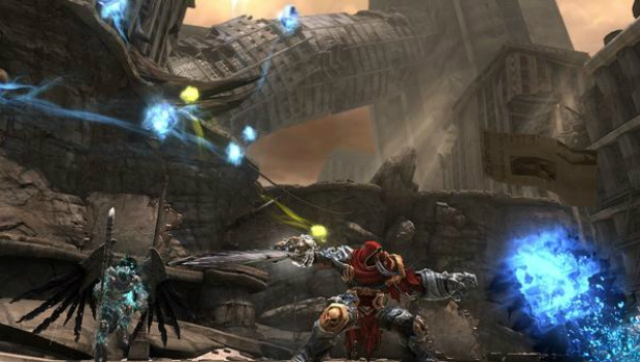The Story Mechanic Part Four: Masters of a Universe
Regular visitors to GodisaGeek.com will know that, far from just being one of the best news, reviews, features and podcast sites on the internet (*payrise forthcoming*), GiaG is also home to the official Darksiders Fan Club. Whilst I don’t want to speak for everyone who works here, everyone thinks Darksiders is absolutely fuggin’ fantastic. Again, without wanting to put words in people’s mouths, we all think that it is one of the underrated classics of this console generation with possibly the greatest fist-in-the-air, heart-in-the-mouth, twinge-in-the-trousers endings of any game. Ever.
With that in mind, I stuck the Darksiders disc back into my PlayStation 3 the other day, aiming for one “Apocolyptic” level playthrough of War’s adventure before gearing up for a run-out as Death in the upcoming sequel. I knew what I expected; a Zack Snyder meets ancient folklore story with that ending, slightly marred by a sluggish control scheme that made platforming sections tough and combat unfairly punishing. My memory of the game was of one that I loved despite the gameplay; one carried by the premise, the story and the universe. That’s how I have always defended Darksiders from anyone who criticised it: the premise was brilliant, everything, from the characters to the melodrama to the action, was gloriously over the top, and it was all tied together by a plot full of mystery. It provided the player with a puzzle to solve whilst the world exploded around their head. To me, the world of Darksiders carried the gameplay, raising the quality of the experience.
The mind can be a tricky thing and, in my case, not something to be trusted.

The first thing that I noticed on my new playthrough was that Darksiders’ gameplay was tighter than I recalled. The controls were more responsive, exploring the world less pernickety. Importantly, the story points, the cutscenes and character dialogue that I remembered enjoying were far more sparse than I thought. Often hours of gameplay would pass between these sequences and, whilst still cool, they were shorter and more perfunctory than I remembered. Despite that, I am fifteen hours into this new playthrough. Praise indeed, considering how few games I have finished over the last few months and how few have truly grabbed and held my interest.
All this got me to thinking, my overriding memory of Darksiders was as a great story, but actually the traditional story elements, those that would have been scripted, the dialogue and cutscenes, are not quite as strong as I remembered. Was it just a false memory? I don’t think that it is. I think that what is going on here is a prime example that, when it comes to games, the writer is not the only person responsible for the story. The question then becomes, who is?
Flint Dille and John Zuur Platten, in their book “The Ultimate Guide to Videogame Writing and Design”, have a nice line about writing in games. They talk about times when they have been asked to insert dialogue into a game, turning a bag of ideas into a cohesive story, then explain that it is not that simple. Dialogue is just the tip of the iceberg; you need “something for your characters to talk about”. The point is simple; you need to be thinking about story from the beginning. The core idea for the game has to be strong, and has to be able to support an interesting world around it. As John Feil explains in his chapter on action games in Depain’s “Writing for Videogames”, action games are usually divided up into a number of locations, they become an incredibly important part of the story, used to reinforce immersion, narrative and characters. Dialogue alone doesn’t make a story, many aspects need to work together for a story to build without seeming disjointed.

Whilst this all sounds very easy, there are many potential pitfalls. Gears of War 2 had locations that supported narrative and immersion; brown and grey underground caves which the Gears had to fight through to reach the Locust nest. Utterly consistent with the universe, but shockingly dull, indistinguishable from each other and totally forgettable. Gears 3 addressed this directly. Levels were more colourful and more varied (each occupies its own space in my memory) but some could be criticised as stretching the credibility of the universe beyond its breaking point (I’m looking at you, “Golden City in the Hurricane”). The point here is designing levels that truly support a game’s story (and vice versa), whilst also being interesting playgrounds to play the game in, is an incredibly tricky tightrope. Examples are few, but those that do it well (Arkham City, Rapture, Dubai), resonate with gamers. It is no coincidence that the studios which developed these game worlds pride themselves as storytelling studios. A counter point example would be iD Software, who created the apocalyptic wasteland in Rage. A technical marvel, rightly a point of pride, but one which was completely inert and utterly devoid of story. It just wasn’t the studio’s focus. The goal was to create a landscape that showed off the technology, not tell a story with it. It shows.
Rage didn’t need a brilliant story to be a brilliant game, but it could still have been better for it. Games include stories to increase the immersion in the game world. Player’s identify with characters and can pinpoint the agency they have in the game world using the context provided by story. However, immersion is the goal of every design department. QA testing eliminates the bugs that snap immersion. Music heightens immersion and draws the player into the world. Designing compelling gameplay is key to grabbing and holding a player’s attention. Every department is pulling in that same immersive direction.

For Darksiders, then, the story succeeds because of the universe. The premise, the betrayal of the First Horseman, is a brilliant one. The narrative, presenting the plot as a mystery, builds on that premise by adding curiosity and discovery. Art adds incredible character designs and beautiful worlds that are fun to explore. Level design makes sure that levels have plenty of areas that need to be explored, in line with the thrust of the story. Game design ensures that everything you find on your travels adds nuance, depth and fun to the overall gameplay package. This fun gameplay keeps you driving through until the next plot point; then the cycle continues.
So, as it turned out, my memory was far from incorrect. It was just my analysis that was faulty. Darksiders didn’t have a good story despite every other aspect of the game being somewhat average. It had a good story because every aspect of the game was working hard and working together to make sure that I got a great story experience.
It is important that we remember that.




